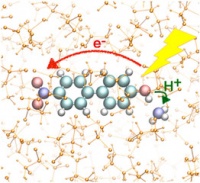 Puja Goyal of Binghamton University, NY will present Nonadiabatic dynamics of photoinduced proton-coupled electron transfer in the condensed phase.
Puja Goyal of Binghamton University, NY will present Nonadiabatic dynamics of photoinduced proton-coupled electron transfer in the condensed phase. Puja Goyal of Binghamton University, NY will present Nonadiabatic dynamics of photoinduced proton-coupled electron transfer in the condensed phase.
Puja Goyal of Binghamton University, NY will present Nonadiabatic dynamics of photoinduced proton-coupled electron transfer in the condensed phase.
Tuesday, October 16th 12:10 pm in CNS 333
Pizza and Beverages Provided
Coupled electron and proton transfer reactions are central to a wide range of energy conversion processes, including those in solar energy devices. An understanding of the fundamental physical principles that govern the nonequilibrium dynamics of electrons and protons in photoinduced proton-coupled electron transfer (PCET) reactions can guide the design of more effective solar devices for energy production and storage. Transient absorption and coherent Raman spectroscopy experiments have demonstrated concerted electron-proton transfer (EPT) to occur upon photoexcitation of some organic hydrogen-bonded dyes and inorganic metal-ligand complexes. Aiming at studying the mechanistic details of such photo-EPT reactions using an efficient computational framework, we use a semi-empirical implementation of the floating occupation molecular orbital complete active space configuration interaction (FOMO-CASCI) method in conjunction with the molecular dynamics with quantum transitions (MDQT) surface hopping method. Fitting the semi-empirical parameters to reproduce data from ab initio multiconfigurational calculations allows on-the-fly generation of potential energy surfaces on which nonadiabatic dynamics is propagated. Solvation effects are included by treating the solvent molecules explicitly with a molecular mechanical (MM) force field, while the solute is treated with quantum mechanics (QM). The nuclear quantum effects of the transferring proton are included using the Fourier Grid Hamiltonian (FGH) method, and the dynamics is carried out on electron-proton vibronic rather than electronic surfaces. We have applied this framework to a specific phenol-amine complex in 1,2-dichloroethane. The nonadiabatic dynamics simulations provide insight into the roles of solute/solvent dynamics, vibrational relaxation, proton delocalization, and electron-proton coupling in the photo-EPT process. They also enable the identification of the physical properties that determine the relaxation timescales and hydrogen/deuterium kinetic isotope effects. This approach can be applied to other systems as well, assisting in the interpretation of experimental data as well as providing experimentally testable predictions.
Individuals with disabilities requiring accommodations should contact Paula Larsen at plarsen@ithaca.edu or (607) 274-3238. We ask that requests for accommodations be made as soon as possible.
https://www.ithaca.edu/intercom/article.php/20181004112103531